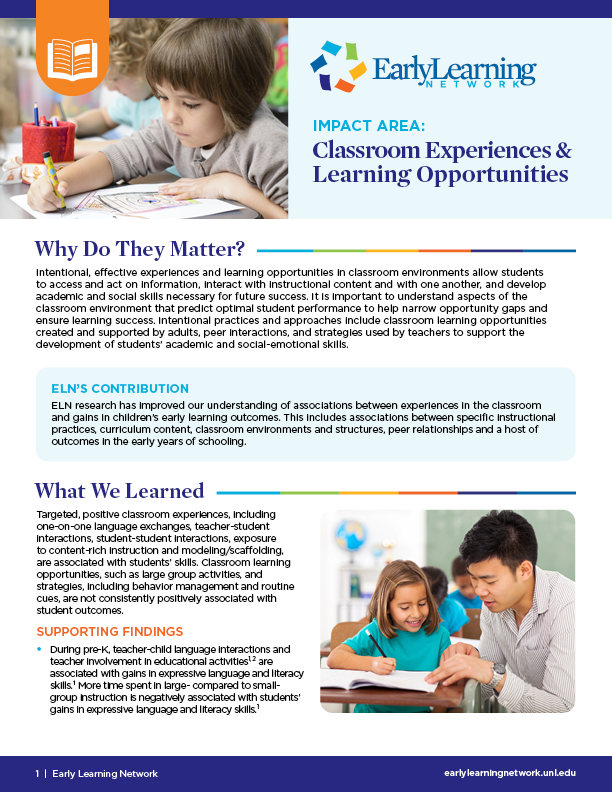
12 Jul Impact Area: Classroom Experiences and Learning Opportunities
Early Learning Network research emphasizes the importance of providing culturally responsive, intentional and supportive interactions in classrooms that focus on students’ social-emotional, cognitive and language development.
Early Learning Network (ELN) teams recently released a set of briefs focused on four impact areas — factors open to change or improvement — that have potential to narrow opportunity gaps and help children maintain early learning success as they transition from prekindergarten (pre-K) to elementary school and beyond.
The primary goal of these briefs is to inform practice and policy decisions that support equitable and effective learning opportunities for children.
This blog highlights the network’s collective research associated with the impact area of Classroom Experiences and Learning Opportunities, including a key takeaway, action steps for practice, policy and research, and insights from the field.
Research Highlights
Classroom Experiences and Learning Opportunities
Why do classroom experiences and learning opportunities matter?
Creating intentional and effective experiences and learning opportunities within classroom environments is essential to support students’ academic and social-emotional growth. It is important to identify and understand classroom factors that predict optimal student performance to address opportunity gaps and ensure learning success is maintained. Intentional practices and approaches include classroom learning opportunities created and supported by adults, peer interactions, and strategies used by teachers to support the development of students’ academic and social-emotional skills.
What has the network contributed to the field in this area?
ELN research has enhanced our understanding of the connections between classroom experiences and early learning outcomes, including associations between instructional practices, curriculum content, classroom environments and structures, peer relationships and a range of outcomes during the early years of schooling.
The network’s research showed targeted, positive classroom experiences, including one-on-one language exchanges, teacher-student interactions, student-student interactions, exposure to content-rich instruction and modeling/scaffolding, are associated with students’ skills. Large group activities and strategies, including behavior management and routine cues, were not consistently positively associated with student outcomes.
What is the network’s key takeaway regarding classroom experiences and learning opportunities?
After analyzing the network’s collective research findings on classroom experiences and learning opportunities, and integrating feedback from geographically diverse practitioners, policymakers, and state and federal partners, a key takeaway emerged:
Children’s opportunities and experiences in classrooms should include culturally responsive, intentional and supportive interactions focused on social-emotional, cognitive and language development.
Action Steps
To implement this key takeaway, the following action steps are suggested:
For Practice:
- Provide pre-service and in-service educators, administrators and support staff with high-quality professional learning opportunities, including customized training and coaching, to support the implementation of culturally responsive, intentional and supportive one-on-one, formal and informal language exchanges; teacher-student and student-student interactions; developmentally sequenced, content-rich instruction and modeling/scaffolding.
For Policy:
- Ensure family voice is included in decision-making structures and processes to enhance learning among all children, including those from marginalized groups.
For Research:
- Develop or improve research-based tools that are culturally responsive for measuring individualized children’s experiences, skills and outcomes, including constructs related to learning, such as creativity, joy and multiple dialects.
Insights from the Field
Jennie Patterson, policy and advocacy manager for the National Black Child Development Institute (NBCDI), served as a panelist during the forum and contributed to the development of these action steps.
In this next section, Patterson offers insights on the network’s findings related to classroom experiences and learning opportunities.
Practice-Focused Insights
According to Patterson, the Early Learning Network’s findings on classroom experiences and learning opportunities align with NBCDI’s vision that “every Black child attends a school that affirms and expands them.” In other words, students’ school experiences support who they are and can be in the future.
“The takeaway statement really embodies the work NBCDI does,” Patterson said. “Children can be affirmed through culturally responsive, intentional and supportive interactions and expanded through practices that support social-emotional, cognitive and language development,” Patterson said.
Providing educators with high-quality professional learning opportunities on culturally responsive practices is key to supporting students’ learning and development, particularly for those who are marginalized.
“Racial bias leads to disproportionate suspensions and expulsions of Black children, which disrupts their learning and negatively impacts families,” Patterson said. “It is crucial to provide training for teachers on culturally responsive practices to address racial bias and also to make sure all children receive high-quality education.”
Patterson noted that teachers’ informal language exchanges with students are opportunities to create inclusive, positive classroom experiences.
“Teachers can support the development of students’ academic and social-emotional skills by using vocabulary that is familiar to students and examples that are part of their environment,” Patterson said. “The use of African American vernacular and everyday words, like those students use at home with their family and friends, can increase engagement.”
Patterson mentioned that the lexicon of African American English will soon be formalized in the Oxford Dictionary of African American English.
Formal learning opportunities, like tests and reading materials, can also be culturally responsive and contribute to children’s educational success.
“If children live in an urban setting, reading a story problem that mentions soccer may not resonate well with them, compared to something like basketball, which they are more likely to see in their communities,” Patterson said. “Intentional, culturally responsive language choices can prevent students from getting hung up on meaning of things and allow them to focus on generating the answer.”
Policy-Focused Insights
The Early Learning Network’s findings support Patterson’s efforts to advance equity for Black children and families.
“As someone in the policy field, these research findings are important because we need evidence to take with us when we go on the Hill and have conversations with policymakers to justify why the policies we’re advocating for are so important and their potential impacts,” Patterson said.
Patterson emphasized the need to ensure family voice is included in school/program decision-making structures and processes, highlighting NBCDI’s efforts to engage families and establish home-school alignment.
“Surveying parents about their experiences is a great way to ensure family voice is included in decision-making,” Patterson said. “Surveys provide qualitative data to understand the needs of students and families and make sure they are addressed. That data can also be used to benefit future students and families.”
Patterson recommended that schools/programs offer several opportunities for parents to be involved in their child’s education — and in ways that suit their needs and availability.
“Most parent-teacher conferences are held at one time, but there are parents who work odd hours and may not be available during traditional hours, so how do we engage those parents who may be harder to reach?” Patterson said. “Policies can be adjusted to make sure there are multiple opportunities for parents to be engaged and ensure all voices are heard,” Patterson said.
The next blog will explore another impact area that emerged from the network’s research: Relationships.



